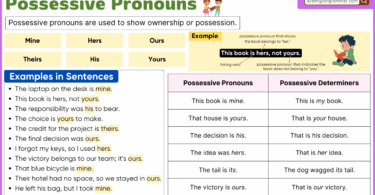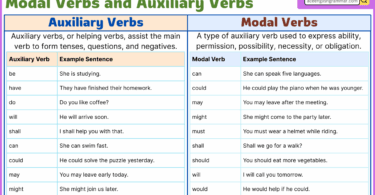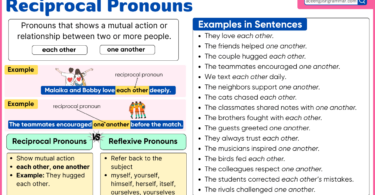An adverb of place provides information about the location or position of an action or event in relation to a specific place. These adverbs provide clarity and valuable information about where something is happening or the direction in which an action is being performed. For instance, when someone asks “Where are you going?” you can use adverbs of place to explain your destination. Examples of adverbs of place include here, there, nearby, away, up, down, etc. They often answer the questions ‘Where?’ or ‘To what place?’ and add depth and clarity to our sentences. So, let’s explore some useful adverbs of place with examples and better understand how they can be utilized in everyday language.
Table of Contents
What is an adverb?
An adverb is a word that describes or modifies a verb, adjective, or other adverb. It tells us how, when, where, or to what extent something happens. For instance, if you say, “She runs quickly,” the word “quickly” is the adverb because it tells you how she runs. Or if you say, “He speaks softly,” “softly” is the adverb because it describes how he speaks. Adverbs often end in “-ly,” but not always. ” There are several types of adverbs including time, place, manner, degree, frequency, and interrogative adverbs.
What is an adverb of place?
Adverbs of place, as the name suggests, give us information about the location, position or direction of an action or verb in a sentence. They answer the question “where?” and help us situate events in space. These adverbs provide context and help listeners or readers visualize the scene by describing where an action is happening or where something is located. For example,
- The library is near the park.
Here “Near” shows the proximity of the library to the park, giving a sense of distance between the two locations. It conveys that the library is not far away from the park.
Common Adverbs of Place:
- Here: This adverb indicates a close or nearby location. For example, “I left my keys here.”
- There: Used to point out a more distant or unspecified place. “The park is over there.”
- Everywhere: Signifying a broad or all-encompassing location. “She searched everywhere for her lost phone.”
- Nowhere: Referring to no particular place. “The mysterious creature seemed to come from nowhere.”
- Somewhere: Denoting an unspecified or unknown place. “I left the book somewhere in the library.”
- Anywhere: Referring to any place without specificity. “You can sit anywhere you like.”
- Above: Indicates a higher position. “The stars twinkled above.”
- Below: Signifies a lower position. “The treasure was buried below the old oak tree.”
- Nearby: Describes a location close to another point. “There’s a cafe nearby.”
- Far: Specifies a great distance. “The mountains are far in the distance.”
Functions of Adverbs of Place
Here are some basic functions of adverbs of place with examples:
- Show Location: Adverbs of place help us know where something is taking place. For example, “She is sitting here.”
- Give Direction: They indicate the direction of movement. “He walked there.”
- Specify Distance: Adverbs of place can tell us how far or near something is. “The park is far.”
- Describe Position: They help describe where something or someone is positioned. “The cat is under the table.”
- Indicate Movement: These adverbs can also show how things move in relation to a place. “The bird flew up into the sky.”
- Offer Context: They add details to make the scene in our minds more vivid. “The treasure was hidden somewhere in the forest.”
- Enhance Descriptions: Adverbs of place make our sentences more interesting and specific. “The flowers are blooming everywhere.”
How to use adverbs of place in a sentence?
Adverbs of place can be placed at different positions in a sentence, depending on the emphasis or clarity you want to convey.
After the Main Verb
Adverbs of place generally come after the main verb in a sentence. For example:
- She walked outside.
- They live down the street.
After the Object
If the sentence has a direct object, the adverb of place usually follows the object. For example:
- He placed the book on the table.
- She found her keys under the couch.
Before the Main Verb
Some adverbs of place, especially short ones, can be placed before the main verb for emphasis. For example:
- Here comes the bus!
- There lies the problem.
Adverbs of Place Uses
- here, there, everywhere, somewhere, nowhere: These adverbs indicate general locations.
- above, below, over, under: They indicate vertical position or relationship.
- in, inside, outside, indoors, outdoors: These indicate whether something is within or outside a specific location.
- near, far: Indicate distance from a point.
- upstairs, downstairs: Show movement within a building.
- north, south, east, west: Indicate direction.
- abroad, overseas, locally: Show location in relation to a specific area.
- anywhere, nowhere: Refer to unspecified or non-specific locations.
Prepositional Phrases
Adverbs of place are also commonly used in prepositional phrases, where the adverb is combined with a preposition to provide more specific location information. For example: on the table, in the park, under the bed, along the street, by the river, at the beach, near the forest, etc.
- We had a picnic in the park.
- The book is on the table.
- They walked along the street.
Compound Adverbs of Place
These are adverbs formed by combining an adverb with another word. For example: upstairs, downstairs, outdoors, indoors, whereabouts, hereabouts, therein, etc.
- The kitchen is downstairs.
- It’s too hot, let’s stay indoors.
- They love to play outdoors.
Word Order Importance
The placement of adverbs of place can impact the meaning of a sentence. Different word orders can emphasize different aspects:
- “He is there now.” (Emphasizing the location)
- “He is now there.” (Emphasizing the timing of arrival)
Types of Adverbs of Place:
- Simple Adverbs of Place: Simple adverbs of place are the basic words that indicate location. Common examples include words like “here,” “there,” “everywhere,” “anywhere,” and “nowhere.” These adverbs offer straightforward information about the place of an action without much complexity.
- Example: The cat is here.
- Compound Adverbs of Place: Compound adverbs of place are formed by adding a preposition to a simple adverb. These adverbs provide more specific details about the location.
- Example: The keys are under the table.
- Interrogative Adverbs of Place: Interrogative adverbs are used to ask questions. Interrogative adverbs of place include words such as “where,” “whence,” and “whither.” They help seek information about the location of an action.
- Example: Where is the nearest grocery store?
- Relative Adverbs of Place: Relative adverbs connect a dependent clause to the main clause, adding information about place. Common relative adverbs of place are “where” and “when.”
- Example: This is the park where we first met.
Example sentences
- Please sit beside me.
- I left my keys here.
- The bus stop is right here.
- She placed the book on the shelf.
- The playground is near the school.
- They went inside the house.
- The stars twinkled above.
- The restaurant is across the street.
- We walked through the park.
- The sun sets behind the mountains.
- The plane is flying high in the sky.
- The treasure is buried deep in the sand.
- The kids are playing nearby.
- The flowers are blooming everywhere.
- The sun is setting behind the hills.
- The squirrel climbed up the tree.
- The kite is flying above the park.
- I left my shoes outside the door.
List of adverbs of place
- here
- there
- everywhere
- somewhere
- nowhere
- near
- far
- abroad
- overhead
- underground
- upstairs
- downstairs
- outside
- inside
- behind
- in front
- nearby
- internally
- externally
- hereabouts
- thereabouts
- indoors
- outdoors
- ahead
- underneath
- back
- forward
- away
- out
- in
- up
- on
- down
- around
- above
- below
- between
- beside
- by
- across
- towards
- over
- beyond
- north
- south
- east
- west
- aside
- within
- without
- right here
- left behind
- in front
- northeast
- northwest
- southeast
- southwest
- in the park
- overseas
- overhead
- underfoot
- underground
- on the hill
- under the bridge
- by the river
- at the store
- across the street
- along the path
- through the forest
- near the beach
- beyond the horizon
- between the buildings
- behind the curtain
- inside the house
- outside the window
- atop the mountain
- under the table
- below the surface
Adverbs of Place Exercises
Q1: Which of the following is an adverb of place?
- Quickly
- Happily
- Here
- Suddenly
Q2: What does an adverb of place describe?
- Time
- Manner
- Location
- Frequency
Q3: In the sentence “The cat is sleeping under the table,” the adverb of place is:
- sleeping
- under
- cat
- table
Q4: Which of the following sentences has an adverb of place?
- She sings beautifully.
- They dance gracefully.
- The book is on the shelf.
- He reads quietly.
Q5: Which question does an adverb of place help answer?
- What?
- When?
- Why?
- Where?
Q6: Choose the correct adverb of place for the sentence: “The cat is hiding ________ the bed.”
- under
- always
- carefully
- quickly
Q7: She looked __________ and saw a rainbow in the sky.
- above
- inside
- quietly
- soon
Q8: He lives _______________ the city.
- on
- under
- outside
- over
Q9: The keys are _______________ the drawer.
- above
- under
- behind
- in
Q10: She placed the vase _______________ the table.
- over
- beside
- upon
- on
Answers:
- c) Here
- c) Location
- b) under
- c) The book is on the shelf.
- d) Where
- a) under
- a) above
- c) outside
- d) in
- d) on
FAQs
Q1. What is an adverb of place?
An adverb of place is a type of adverb that provides information about the location, position, or direction of an action or verb within a sentence. It answers the question “Where?” in relation to the action.
Q2. What is the function of adverbs of place?
Adverbs of place describe where an action is happening or where something is located. They add context and specificity to sentences by indicating the spatial aspects of the action.
Q3: Can adverbs of place be used with both transitive and intransitive verbs?
Yes, They can be used with both transitive (verbs that take a direct object) and intransitive (verbs that don’t require a direct object) verbs. They describe the location of the action in relation to the subject.
Q4: What are some common examples of adverbs of place?
Some common examples include “here,” “there,” “everywhere,” “somewhere,” “nowhere,” “upstairs,” “downstairs,” “inside,” “outside,” “near,” “far,” “above,” “below,” and “abroad.”
Q5: Where can adverbs of place be placed in a sentence?
Adverbs of place can be used at the beginning, middle, or end of a sentence, depending on where the speaker wants to emphasize or create a specific effect. For Example:
- Before the verb: She quickly ran to the store.
- After the verb: He walked there slowly.
- At the beginning or end of a sentence: Here are your keys.
- With the object: She placed the book there.
- Combined with a preposition: They sat on the sofa here.
You May Also Like:




Leave a Comment